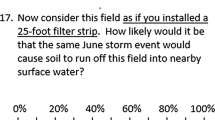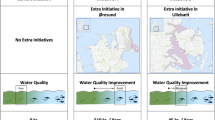Abstract
Data from a discrete choice experiment on improvements of rural landscape attributes are used to investigate the implications of discontinuous preferences on willingness to pay estimates. Using a multinomial error component logit model, we explore differences in scale and unexplained variance between respondents with discontinuous and continuous preferences and condition taste intensities on whether or not each attribute was considered by the respondent during the evaluation of alternatives. Results suggest that significant improvements in model performance can be achieved when discontinuous preferences are accommodated in the econometric specification, and that the magnitude and robustness of the willingness to pay estimates are sensitive to discontinuous preferences.
Similar content being viewed by others
References
Alpízar F, Carlsson F and Martinsson P (2001). Using choice experiments for non-market valuation. Econ Issues 8: 83–109
Bhat CR (2001). Quasi-random maximum simulated likelihood estimation of the mixed multinomial logit model. Transport Res Part B 35: 677–693
Bierlaire M (2003) BIOGEME: a free package for the estimation of discrete choice models. Presented at the 3rd Swiss Transportation Research Conference, Ascona
Blamey RK, Bennett JW, Louviere JJ, Morrison MD and Rolfe JC (2002). Attribute causality in environmental choice modelling. Environ Resour Econ 23: 167–186
Breffle WS and Rowe RD (2002). Comparing choice question formats for evaluating natural resource tradeoffs. Land Econ 78: 298–314
Brownstone D and Train KE (1999). Forecasting new product penetration with flexible substitution patterns. J Econom 89: 109–129
Carlsson F and Martinsson P (2001). Do hypothetical and actual marginal willingness to pay differ in choice experiments?. J Environ Econ Manage 41: 179–192
Campbell D (2007). Willingness to pay for rural landscape improvements: combining mixed logit and random effects models. J Agric Econ 58: 467–483
Campbell D, Hutchinson WG and Scarpa R (2008). Using mixed logit models to derive individual-specific WTP estimates for landscape improvements under agri-environmental schemes: evidence from the Rural Environment Protection Scheme in Ireland. In: Birol, E and Koundouri, P (eds) Choice experiments informing European environmental policy, pp 58–81. Edward-Elgar, Cheltenham
Campbell D, Hutchinson WG, Scarpa R (forthcoming) Using choice experiments to explore the spatial distribution of willingness to pay for rural landscape improvements. Environ Plan A
Caussade S, Ortúzar JD, Rizzi LI and Hensher DA (2005). Assessing the influence of design dimensions on stated choice experiment estimates. Transport Res Part B 39: 621–640
Dellaert BGC, Brazell JD and Louviere JJ (1999). The effect of attribute variation on consumer choice consistency. Market Lett 10: 139–147
DeShazo JR and Fermo G (2002). Designing choice sets for stated preference methods: the effects of complexity on choice consistency. J Environ Econ Manage 44: 123–143
Ferrini S and Scarpa R (2007). Designs with a-priori information for nonmarket valuation with choice-experiments: a Monte Carlo study. J Environ Econ Manage 53: 342–363
Gelso BR and Peterson JM (2005). The influence on the demand for environmental recreation: incorporating lexicographic preferences. Ecol Econ 53: 35–45
Gowdy JM and Mayumi K (2001). Reformulating the foundations of consumer choice theory and environmental valuation. Ecol Econ 39: 223–237
Haaijer R, Kamakura W and Wedel M (2001). The ‘no-choice’ alternative in conjoint choice experiments. Int J Market Res 43: 93–106
Heiner RA (1983). The origin of predictable behavior. Am Econ Rev 73: 560–595
Hensher DA (2006a). How do respondents process stated choice experiments? Attribute consideration under varying information load. J Appl Econom 21: 861–878
Hensher DA (2006b). Revealing differences in willingness to pay due to the dimensionality of stated choice designs: an initial assment. Environ Resour Econ 34: 7–44
Hensher DA (in press) Joint estimation of process and outcome in choice experiments and implications for willingness to pay. J Transport Econ Policy
Hensher DA and Bradley M (1993). Using stated response data to enrich revealed preference discrete choice models. Market Lett 4: 139–152
Hensher DA, Rose JM and Bertoia T (2007). The implications on willingness to pay of a stochastic treatment of attribute processing in stated choice studies. Transport Res Part E 43: 73–89
Hensher DA, Rose JM and Greene WH (2005). The implications on willingness to pay of respondents ignoring specific attributes. Transportation 32: 203–222
Herriges JA and Phaneuf D (2002). Inducing patterns of correlation and substitution in repeated nested logit models of recreation demand. Am J Agric Econ 84: 1076–1090
Kontoleon A and Yabe M (2003). Assessing the impacts of alternative ‘opt-out’ formats in choice experiment studies: consumer preferences for genetically modified content and production information in food. J Agric Policy Resour 5: 1–43
Lancaster KJ (1966). A new approach to consumer theory. J Polit Econ 74: 132–157
Lancsar E and Louviere JJ (2006). Deleting ‘irrational’ responses from discrete choice experiments: a case of investigating or imposing preferences?. Health Econ 15: 797–811
Lehtonen E, Kuuluvainen J, Pouta E, Rekola M and Li CZ (2003). Non-market benefits of forest conservation in sourthern Finland. Environ Sci Policy 6: 195–204
Lockwood M (1996). Non-compensatory preference structures in non-market valuation of natural area policy. Aust J Agric Econ 40: 73–87
Lockwood M (1999). Preference structures, property rights and paired comparisons. Environ Resour Econ 13: 107–122
Louviere JJ and Hensher DA (1982). Design and analysis of simulated choice or allocation experiments in travel choice modeling. Transport Res Rec 890: 11–17
Louviere JJ and Woodworth G (1983). Design and analysis of simulated consumer choice or allocation experiments: an approach based on aggregate data. J Market Res 20: 350–357
Louviere JJ, Hensher DA and Swait J (2000). Stated choice methods: analysis and application. Cambridge University Press, Cambridge
Luce MF, Payne JW and Bettman JR (2000). Coping with unfavorable attribute values in choice. Organ Behav Human Decis Process 81: 274–299
McIntosh E and Ryan M (2002). Using discrete choice experiments to derive welfare estimates for the provision of elective surgery: implications of discontinuous preferences. J Econ Psychol 23: 367–382
Payne JW, Bettman JR and Johnson EJ (1993). The adaptive decision maker. Cambridge University Press, Cambridge
Puckett SM, Hensher DA (2008) The role of attribute processing strategies in estimating the preferences of road freight stakeholders under variable road user charges. Transport Res Part E 44:379–395
Rekola M (2003). Lexicographic preferences in contingent valuation: a theoretical framework with illustrations. Land Econ 79: 277–291
Rosenberger RS, Peterson GL, Clarke A and Brown TC (2003). Measuring dispositions for lexicographic preferences of environmental goods: integrating economics, psychology and ethics. Ecol Econ 44: 63–76
Sælensminde K (2001). Inconsistent choices in stated choice data: use of the logit scaling approach to handle resulting variance increases. Transportation 28: 269–296
Sælensminde K (2002). The impact of choice inconsistencies in stated choice studies. Environ Resour Econ 23: 403–420
Sælensminde K (2006). Causes and consequences of lexicographic choices in stated choice studies. Ecol Econ 59: 331–340
Samuelson W and Zeckhauser R (1988). Status-quo bias in decision-making. J Risk Uncertain 24: 7–59
Sándor Z and Wedel M (2001). Designing conjoint choice experiments using managers’ prior beliefs. J Market Res 38: 430–444
Scarpa R, Ferrini S and Willis KG (2005). Performance of error component models for status-quo effects in choice experiments. In: Scarpa, R and Alberini, A (eds) Applications of simulation methods in environmental and resource economics, pp 247–273. Springer Publisher, Dordrecht
Scarpa R, Campbell D and Hutchinson WG (2007a). Benefit estimates for landscape improvements: sequential Bayesian design and respondents’ rationality in a choice experiment study. Land Econ 83: 617–634
Scarpa R, Willis KG and Acutt M (2007b). Valuing externalities from water supply: status quo, choice complexity and individual random effects in panel kernel logit analysis of choice experiments. J Environ Plan Manage 50: 449–466
Scott A (2002). Identifying and analysing dominant preferences in discrete choice experiments: an application in health care. J Econ Psychol 23: 383–398
Spash CL (2000). Ecosystems, contingent valuation and ethics: the case of wetland re-creation. Ecol Econ 34: 195–215
Spash CL and Hanley N (1995). Preferences, information and biodiversity preservation. Ecol Econ 12: 191–208
Swait J and Louviere JJ (1993). The role of the scale parameter in the estimation and comparison of multinomial logit models. J Market Res 30: 305–314
Sugden R (2005). Anomalies and stated preference techniques: a framework for a discussion of coping strategies. Environ Res Econ 32: 1–12
Train KE (2003). Discrete choice methods with simulation. Cambridge University Press, Cambridge
Author information
Authors and Affiliations
Corresponding author
Rights and permissions
About this article
Cite this article
Campbell, D., Hutchinson, W.G. & Scarpa, R. Incorporating Discontinuous Preferences into the Analysis of Discrete Choice Experiments. Environ Resource Econ 41, 401–417 (2008). https://doi.org/10.1007/s10640-008-9198-8
Received:
Accepted:
Published:
Issue Date:
DOI: https://doi.org/10.1007/s10640-008-9198-8




